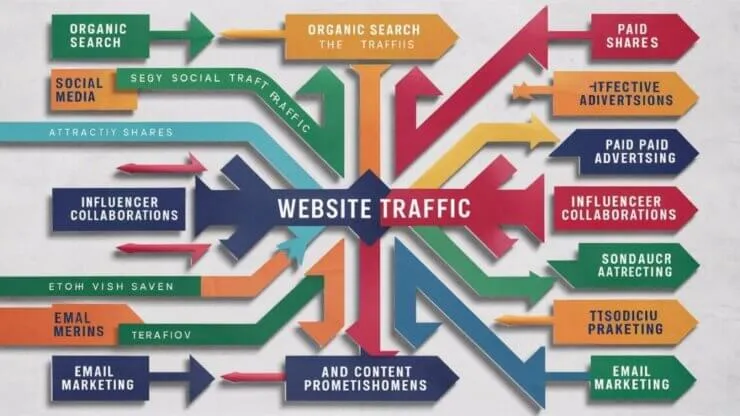Unlocking the Secrets: What is the Best Source of Website Traffic?
In the vast digital landscape, where millions of websites compete for attention, understanding the best sources of website traffic is essential for anyone looking to boost their online presence. Whether you’re a seasoned marketer, a small business owner, or an aspiring blogger, knowing where your visitors come from can help you tailor your strategies to attract more traffic and convert that traffic into loyal customers. Let’s dive into the most effective sources of website traffic and how you can leverage them for your success.
Understanding Website Traffic
Before diving into specific sources of traffic, it’s essential to understand what website traffic actually means. In simple terms, website traffic refers to the number of visitors that come to your site over a specific period. These visitors can come from various sources, including search engines, social media platforms, referral websites, email campaigns, and direct visits.
Measuring traffic is vital because it provides insight into how well your marketing strategies are working. High traffic can lead to increased brand awareness, more leads, and ultimately higher sales. However, not all traffic is created equal. The goal should be to attract relevant visitors who are genuinely interested in your content or offerings.
The Top Sources of Website Traffic
Now that we understand the importance of website traffic, let’s explore some of the best sources available:
1. Organic Search Traffic
One of the most effective and sustainable sources of website traffic is organic search traffic. This refers to visitors who find your site through search engines like Google or Bing without any paid advertising involved. To attract organic traffic, you need to focus on Search Engine Optimization (SEO).
SEO Best Practices:
– Keyword Research: Identify relevant keywords that potential customers are searching for and integrate them into your content.
– Quality Content: Create high-quality, informative content that addresses users’ needs and queries.
– On-Page SEO: Optimize title tags, meta descriptions, header tags, and images for better visibility in search results.
– Link Building: Establish backlinks from reputable sites to improve your domain authority.
While organic search can take time to yield results, it often leads to high-quality traffic that converts well.
2. Social Media Traffic
Social media platforms like Facebook, Instagram, Twitter, and LinkedIn are powerful tools for driving traffic to your website. With billions of active users worldwide, social media provides an excellent opportunity to connect with potential customers.
Tips for Driving Traffic via Social Media:
– Engaging Content: Share eye-catching visuals and compelling captions that encourage users to click through to your site.
– Regular Posting: Maintain a consistent posting schedule to keep your audience engaged and informed.
– Utilize Ads: Consider using paid advertising options on social media platforms to reach a broader audience.
– Influencer Collaborations: Partner with influencers in your niche who can promote your brand and direct their followers to your site.
By effectively leveraging social media, you can significantly increase your website’s visibility and attract new visitors.
3. Email Marketing
Email marketing remains one of the most effective channels for driving traffic. By building an email list of interested subscribers, you can send targeted campaigns that encourage them to visit your website.
Strategies for Effective Email Marketing:
– Build a Quality List: Use lead magnets such as free eBooks or exclusive discounts to entice users to sign up for your newsletter.
– Segment Your Audience: Divide your email list into segments based on interests or behaviors for more personalized messaging.
– Compelling Subject Lines: Craft attention-grabbing subject lines that compel recipients to open your emails.
– Clear Call-to-Actions (CTAs): Include strong CTAs in your emails that lead recipients directly to relevant pages on your website.
With well-executed email marketing campaigns, you can drive consistent traffic while nurturing relationships with potential customers.
4. Referral Traffic
Referral traffic comes from other websites linking back to yours. This can happen through guest blogging, partnerships, or simply having engaging content that others want to share.
How to Boost Referral Traffic:
– Guest Blogging: Write guest posts on reputable blogs in your industry with links back to your site.
– Collaborate with Others: Partner with complementary businesses or influencers for cross-promotions.
– Create Shareable Content: Develop infographics or valuable resources that others may want to share on their platforms.
By increasing referral links pointing towards your site, you not only gain more visitors but also enhance your credibility within your industry.
5. Paid Advertising
While many prefer organic methods for driving traffic due to cost-effectiveness, paid advertising can be highly beneficial when executed correctly. This includes pay-per-click (PPC) campaigns through platforms like Google Ads or sponsored posts on social media.
Maximizing Paid Advertising:
– Targeted Campaigns: Use demographic targeting features available on platforms like Facebook and Google Ads to reach specific audiences.
– A/B Testing: Experiment with different ad copies and visuals to see which perform best.
– Set Clear Goals: Define what you want from the campaign—whether it’s clicks, conversions, or brand awareness—and optimize accordingly.
Paid advertising can provide immediate results and help boost visibility quickly when you’re looking for fast growth.
The Importance of Diversifying Traffic Sources
While each source has its strengths and weaknesses, relying solely on one channel can be risky. For instance, if Google updates its algorithm affecting organic search rankings or if social media platforms change their algorithms limiting reach—your traffic could plummet overnight.
Diversifying your traffic sources allows you to create a more stable foundation for growth. By combining efforts across different channels—such as SEO for organic growth, social media for engagement, email marketing for retention—you create a comprehensive strategy that maximizes visibility and attracts diverse audiences.
Conclusion: Finding Your Best Source of Website Traffic
Ultimately, there isn’t a one-size-fits-all answer when it comes to identifying the best source of website traffic. Each business will have unique needs based on its goals and target audience. Experimenting with various channels while tracking performance will help you find what works best for you.
So whether you choose organic search optimization or dive into paid advertising—embrace the journey! Remember that growing website traffic is an ongoing process requiring patience and adaptability. By understanding these channels and implementing effective strategies tailored specifically for you, you’ll be well on your way to unlocking the full potential of your online presence!





